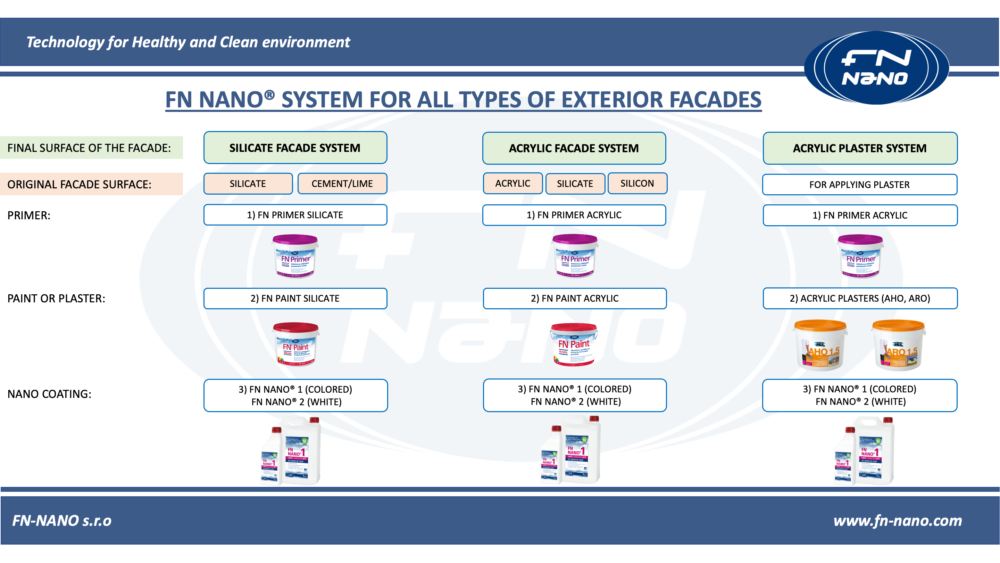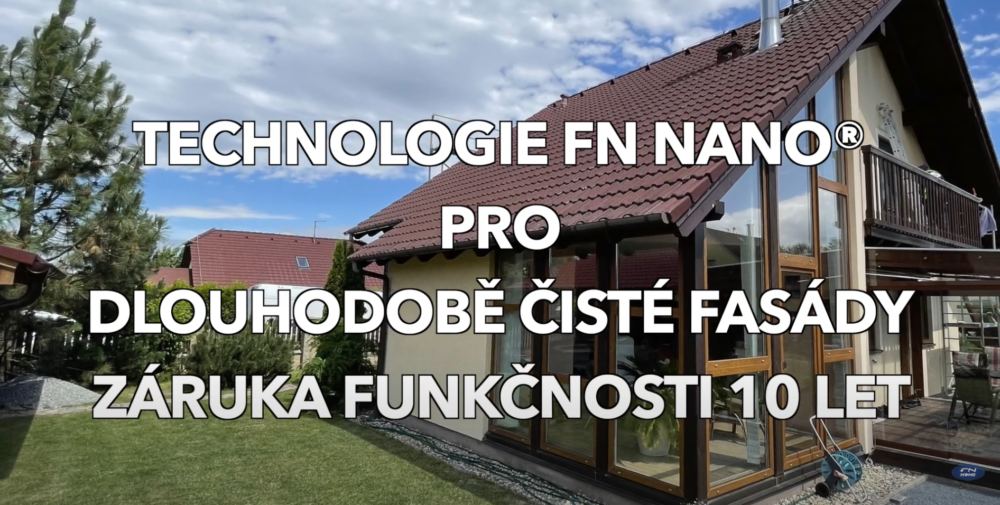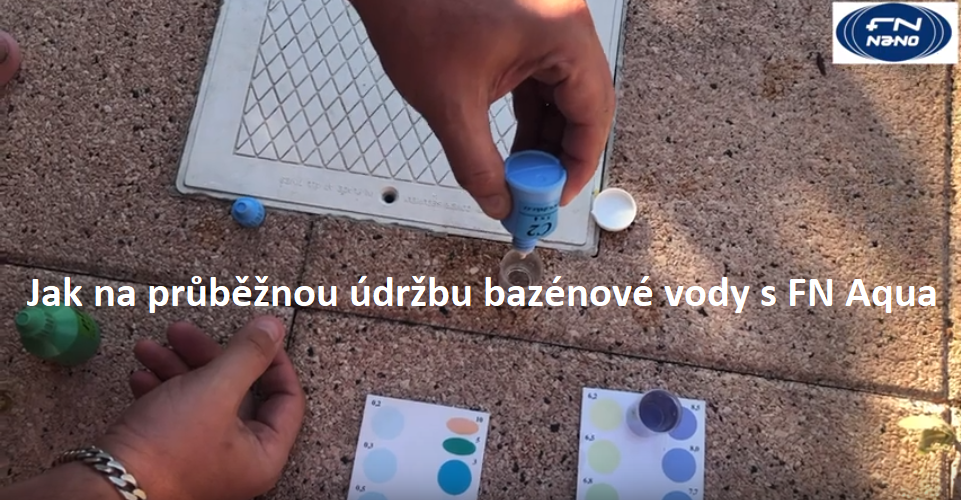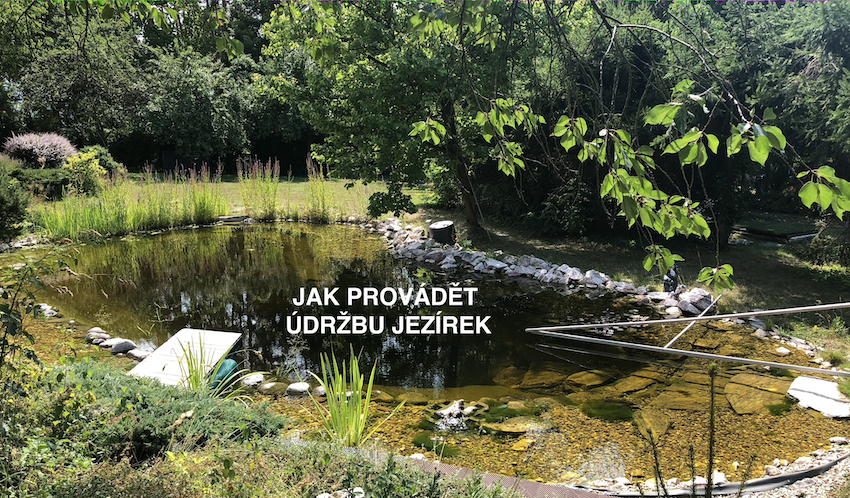SIMPLIFIED MANUAL FOR FN NANO® COATING APPLICATION:
- FN NANO® nano coatings are NEVER diluted and NOT MIXED into anything !
- The tools are always cleaned with water immediately after use.
- The coating must be mixed very thoroughly by shaking in the original packaging before use.
- A very thin and continuous layers must be formed. Three layers are always applied.
- Always apply FN NANO® functional coatings only on suitable, clean and cohesive substrates. Silicate and acrylic paints are also suitable substrates. If you are unsure of the suitability of the substrate, test it by applying a test coat of FN NANO® to a small surface (in the interior, apply near a window), allow it to dry and check the next day for flaking, cracking, peeling or yellowing. If this is the case, the old coating should be removed and a new coat of a suitable paint should be applied.
- Surfaces with a strong hydrophobic (water-repellent) effect are unsuitable substrates. FN NANO® is an aqueous suspension. On such a surface it forms beads (droplets) so a continuous coating will not form. It is not suitable for application on a substrate of clay glued paints! Such old paint must be scraped off and washed down to the stucco.
- Care must be taken to avoid wetting the substrate when applying the FN NANO® functional coating. In this case, organic substances may leach from the substrate into the coating formed by the functional coating. In the interior, it is always recommended to use primer FN® Primer Acrylic and repaint the surfaces with a high quality silicate paint FN® Sensitive Silicate.
- If FN NANO® functional coatings are applied to walls that are heavily contaminated by smoke pollution (e.g. restaurants, bars, smoking rooms, etc.), the substrate must be impregnated with a deep-penetrating primer before applying FN NANO®. Otherwise, dirt deposited inside the plaster and wall can rise to the surface layer. This can make the wall yellow, and stains may appear.
- To create, for example, 10 m2 of photoactive surface indoors, it is necessary to apply 1 liter (undiluted and perfectly mixed!!!) of FN NANO® functional coating evenly over this area in three layers. This quantity is optimal to ensure sufficient thickness of the photoactive layer that will be created by the coating. The uniformity of the application of the material and the thickness of the layer formed are a necessary condition to ensure its correct functionality. If this application principle is not followed and too weak a layer is formed (for example, by inappropriate saving or dilution of the coating with water), the photocatalytic effect may also affect the substrate, which may result in yellowing and odor. It is also not desirable to apply too thick a layer, particularly because of the risk of cracking and flaking.
- The individual layers must be applied in such a way that the second layer is applied after the first layer has almost dryed. Apply the third coat after the previous two coats have completely dried.
- FN NANO® functional coating can be applied by brush, roller or spray.
- The spraying method ensures uniform application of the material, fast workflow and lower consumption on the absorbent surface. Spraying should be carried out using equipment that produces the finest possible droplets. Professional or semi-professional spray guns of the HVLP type with nozzles designed for painting work have proven to be suitable for interior work. Airless high pressure sprayers with paint agitator can also be used for large area applications outdoors. Mechanical sprayers and sprayers are not recommended for the application of FN NANO® coatings as they do not produce uniform droplets.
- Spray as evenly as possible. In this way, apply the aerosol “mist” evenly and in a thin layer to the substrate. Take care not to create wet shiny spots on the substrate when spraying. These are a sign that too large layer is being formed. They can cause the paint to run off, or the substrate to become waterlogged or cracked.
- Proven semi-professional instruments: the Wagner W550, Gracco and others. Use of other types of equipment is possible.
- For roller application, FN NANO foam roller is the most suitable for interior use, low-profile roller can also be used. For applications on rough surfaces (e.g. facades) we recommend rollers with a longer hair or a combination of roller and brush (very rough surfaces). The application should be done at a brisk pace with a semi-wet roller (not over soaked), especially on more absorbent substrates, to avoid soaking and excessive material consumption. The use of a brush is advisable where spraying or roller application is not possible. Always proceed to form a continuous layer.
- Surfaces that are not coated with the FN NANO® functional coating and objects in rooms where the coating is applied must be thoroughly covered with a protective plastic foil. It is recommended to cover the edges of the foil and fix them with painter’s tape.
- The functionality of the created FN NANO® photoactive surface is ensured in the exterior by the impact of daylight, which contains an ultraviolet light, in the interior it is necessary to provide illumination with an artificial source of ultraviolet (UVA) light (suitable sources are in the range of 350 – 375 nm, the optimal wavelength for photoactivation is 365 nm). The minimum power output of the source in relation to the illuminated area is governed for UV-A lamps by the rule of 1 W of source power per 1 m2 of illuminated area. The minimum UV-A irradiance to ensure the functionality of the photocatalytic area is 0,2W/1 m2.
Application of FN NANO® coating in interiors – diagram and video: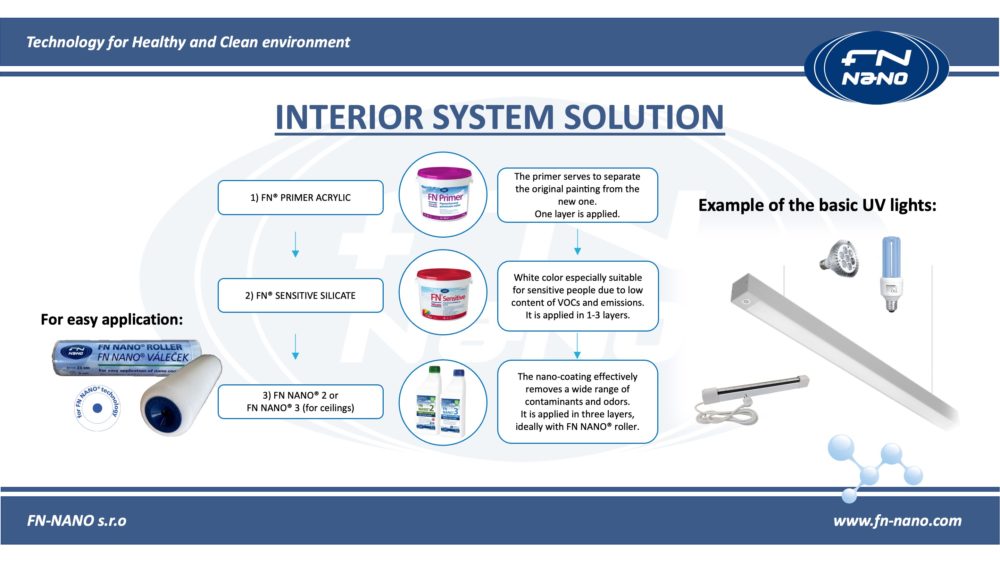

Application of FN NANO® coating in exteriors – diagram and video:
How to correctly apply FN NANO® Wood to wood:
Digram of substrates suitable for FN NANO® technology:
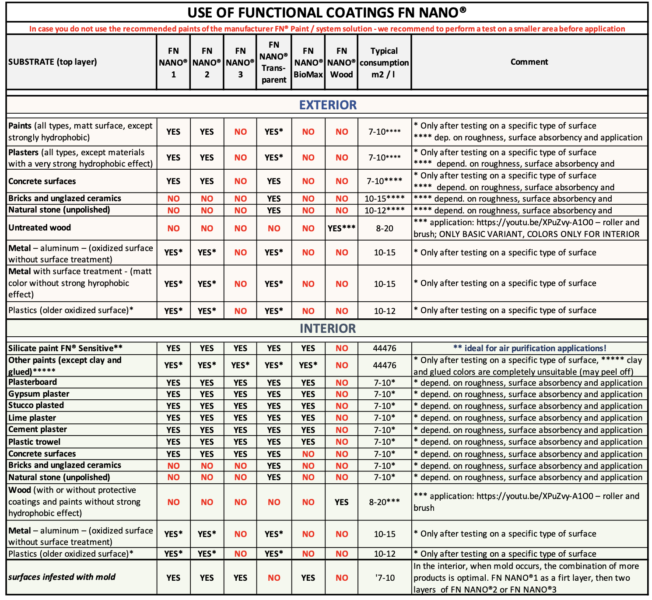
How and when to illuminate with UVA light
In order to ensure the functionality of the created photoactive layer, it is necessary that the treated areas The FN NANO ® functional coating caused daylight or illumination with a soft source of ultraviolet (UVA) light. The recommended intensity is 20 μW / cm² (0.2W / 1m 2 ). For much polluted spaces, it is recommended to increase this intensity approximately 5x. At stated, UVA resources are completely harmless to the health of both humans and animal darlings. For clarification: in the winter months in cloudy skies, the intensity of UV radiation in daylight is 10x higher than the recommended indoors saturation values of our coatings.
The optimal wavelength for photoactivation is 365 nm.
Outside (in the exterior), throughout the year (including the winter months) in daylight (even in the shade), contains such an amount of UV radiation that ensures full photocatalytic cleaning performance of the paint layer FN NANO®.
Inside buildings, in interiors, however, the situation is different. There is no daylight in a number of spaces, and where there are windows, very little ultraviolet radiation penetrates through their glass. If we want to ensure good functionality of photocatalytic coating even in the interior where there is not enough UV radiation from daylight, it is necessary that the painted surface is saturated with ultraviolet light with a wavelength of 365 nm (UVA).
While ultraviolet light with shorter wavelengths activates the photocatalytic process too, it can cause harm to health when it is used. Therefore, the use of UV resources referred to as UVB and UVC is recommended only in specialized workplaces such as biolaboratories, hospitals, etc.
 We always install the light source so that the light is directed at the photocatalytic surface created by the FN NANO® coating:
We always install the light source so that the light is directed at the photocatalytic surface created by the FN NANO® coating:
Scheme of possible illumination of the ceiling of the room with a source of UV light:
The minimum power of the source in relation to the enhanced area shall be governed for UVA fluorescent lamps according to rule 1W of the electrical power supply per 1m of the saturated area. The minimum intensity of UV-A radiation to ensure the functionality of the photocatalytic area is 0.2W/1m. The higher the intensity of UV radiation impacting the photocatalytic surface, the better its surface is able to break down harmful substances in the air and dispose of microorganisms. Follow the instructions of the manufacturers of light sources, and when using UVA lamps with high power, the light was directed to surfaces painted with FN NANO® and did not shine directly into people’s eyes.
UVA lights and bulbs can be purchased with normal processes (on-line, mainly). Most commonly used are actinic UVA fluorescent lamps emitting blue-white light or “Disco light” (Black Light) fluorescent lamps emitting UVA radiation in the invisible part of the spectrum. In addition to fluorescent lamps, some types of special lamps and LEDs that produce UVA radiation of the recommended 365 nm wavelength can be used.
For effective lighting, it is important to pay attention to the selection of a suitable luminaire in which a fluorescent lamp or other UVA light source is placed. When choosing lights, prefer aluminum reflectors. *Note aluminum foils reflect UV radiation while steel, enamel and other materials absorb it. This deprives us of the required light output.
Ultraviolet light activators (UVA 365 nm)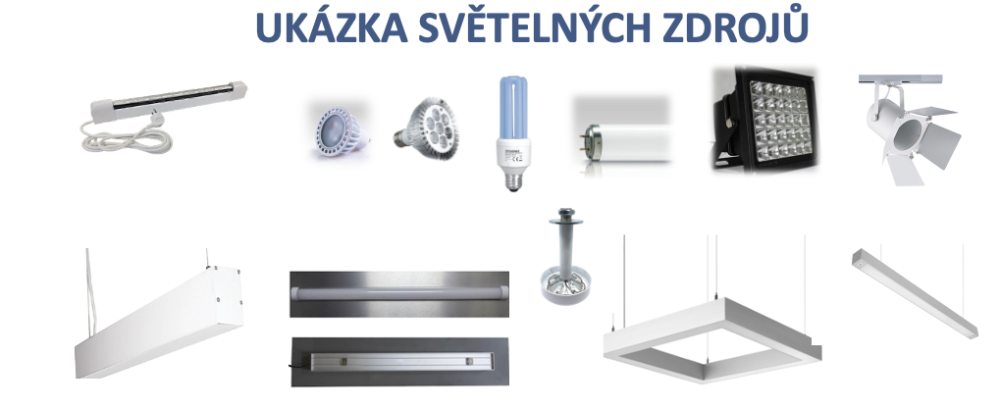
How to apply FN NANO® Aqua
FN NANO® Aqua serves to reduce the consumption of chemicals in the maintenance of pool water and chemical-free maintenance of ponds.
The substances contained in the suspension by physical and mechanical influences effectively prevent the overgrowth of undesirable microorganisms. They make it possible to reduce the amount of chemicals used to maintain water and maintain its quality. Daylight is a condition for proper function and we recommend using it together with a UV lamp, wherever possible.
The preparation reduces the overgrowth of microorganisms by using the following
mechanisms:
- coating microorganisms with inorganic film,
- cutting off nutrients
- UV absorption prevents photosynthesis.
- The light-activated particles of photoactive titanium dioxide exert a huge energy of released electrons and electron holes on the surface of bacteria, where they rupture the molecules of organic matter that make up their cell wall. This will cause it to rupture and subsequently disappear.
RECOMMENDATIONS FOR USE:
OUTDOOR OPEN SWIMMING POOLS:
It is suitable for outdoor outdoor pools or pools with a fine sand filtration system or filter cartridge containing zeolites (eg ZELBRITE) and equipped with recirculation with a UVC lamp (hard antibacterial radiation).
It is not suitable for public swimming pools and swimming pools without perfect and regular maintenance.
ROOFED SWIMMING POOLS:
It is suitable for roofed swimming pools with fine sand filtration or a filter cartridge containing zeolites (eg ZELBRITE) and a UV lamp, which is part of the filtration system and is used regularly. The possibility to open the swimming pool in summer for direct sunlight is an advantage.
GARDEN POND:
Very suitable for maintenance of garden ponds.
FN NANO® AQUA can be used in parallel with chemicals.
APPLICATION PROCEDURE AND PRINCIPLES:
Consumption and dosage:
FN NANO® AQUA (hereinafter FNA) is supplied as a concentrated suspension in plastic bottles with a volume of 0.25, 0.5, one or five liters.
For continuous maintenance in order to reduce the amount of chemicals for pool water maintenance, 0.1 liter of FNA concentrate is used per 10 m3 of pool water, ie 50 ml of FNA concentrate.
The application of FNA is carried out in the prescribed amount regularly in the interval of 7-14 days according to the water level in the pool and the intensity of use.
Preparation of the suspension and its application to water:
The FNA is applied to the pool diluted and freshly blended.
Preparation of diluted FNA:
Shake the FNA perfectly (1 min.) In the original bottle and pour the required amount into a larger container, where it is perfectly mixed with a bar mixer with at least 0.5 liters of water. Mix for at least 3 minutes.
2. FNA dilution:
Gradually and evenly add the required amount of water to the mixed FNA and continue mixing. The recommended mixing time is at least 8 minutes. and follow the breaks recommended by the mixer manufacturer. Note The better we mix, the better the function and the lower the consumption.
Adherence to the suspension preparation procedure is important to achieve a perfect distribution of its mineral components in the water, and thus to ensure good functionality of the product!
APPLICATION VIDEOS:
Ongoing pool water maintenance:
How to perform pond maintenance without chemicals:


